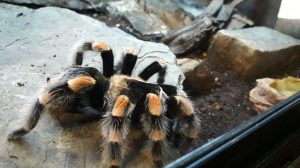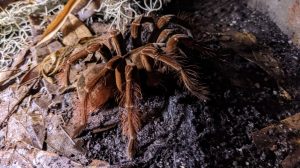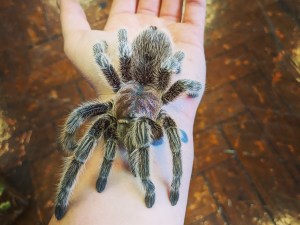TARANTULA TIME!

Have you met Plantasia Tropical Zoo’s very own Tarantulas?
In the ‘Underground’ zone, you can meet Plantasia Tropical Zoo’s Mexican Red Knee and Goliath Birdeater tarantulas,
safely secured within their cosy enclosures.


| Mexican Redknee Tarantula (Unamed) | Goliath Birdeater Tarantula (Aragog) |
| Colour: Black and brown hairs across the body, reddish bands across leg joints
Leg span: 15-17cm Habitat: Mexican desert and scrublands |
Colour: rusty brown to black
Leg span: up to 30cm Habitat: South American Rainforests |
If you run into a member of the team while they are out on the road, attending events and venues across South Wales, you may even be fortunate enough to meet my personal pet tarantula.

I have owned 15-year-old ‘Daisy’ the Chilean Rose Tarantula since 2019. To begin with, I was just as nervous as the next person of arachnids… but caring for Daisy and speaking to people all over the UK about these often-misunderstood critters, has left me with a real fascination and admiration for these wonderful, diverse and important animals.
So, what makes us so frightened of spiders?
Is it the way they walk?
Attempts to rationalise fear usually pay mention to the ‘way they move’. The way in which a spider walks is so completely different to how humans move, it’s hardly surprising that it makes many of us so nervous. Muscles are used to flex their limbs inward, nothing unusual about that… However, the use of hydraulic pressure (think fuel pumps, airplanes and even dishwashers!) to extend them again is simultaneously totally alien and completely intriguing.
Does the thought of ‘all those eyes’ have you tearing up?
Most spiders (including our tarantulas) have eight orb-like eyes. This allows them almost 360° vision, the true living example of ‘eyes in the back of your head’. Despite this, spiders largely have extremely poor eyesight, relying on touch, vibration and taste stimuli to hunt their prey.
Maybe it’s in the way they creep?
I’m often met with anecdotes of “that time a spider ran right at me across the living room floor” or similar. While this can be unnerving, be assured that your eight-legged friend is simply trying to find themselves a dark corner of the room where they can feel safe and secure and set up house, you just happen to be in their way.
If you’re able to accept their presence in the corners of your home, spiders will happily snack on pests such as flies, ants, aphids and even occasional wasps! If not, it’s best to gently relocate them to a shed or garage.
Now for something that may set your teeth a-chattering…
The fangs!
Spiders have hollow fangs, designed to inject venom into their unfortunate prey. While tarantula may give a painful bite, the venom is rarely dangerous to humans, in fact without an allergy, the bite of a birdeater tarantula is no worse than a sting from a wasp (still definitely ouchie!).
Most spiders do not possess fangs capable of penetrating human skin.
The vast majority of native UK species are completely harmless, helpful in controlling the insect population, and just as important to our ecosystem as our less controversial wildlife!
By Zookeeper Lucy Williamson
